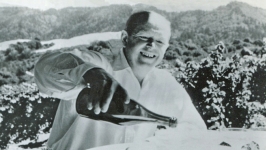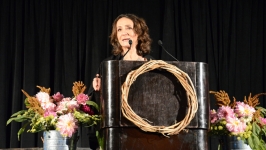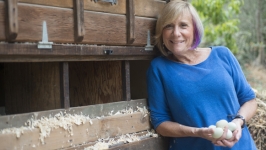Jeffrey & Ellie Patterson : Mountaintop Wine Masters
Cultivating wines with layers and craftsman mastery at Silicon Valley’s storied Mount Eden Vineyards
Two miles up a mostly unpaved, twisty road with corkscrew turns, Mount Eden Vineyards' estate vineyards and winery are slowly revealed to visitors making the drive up from Saratoga. Similarly, the rich, layered history behind the wine label has been developing over the past 75 years.
Here, perched on a mountaintop 2,000 feet above Silicon Valley, grape grower and winemaker Jeffrey Patterson crafts some of the most exquisite, most critically acclaimed wines in the Santa Cruz Mountains, with a distinct “taste of place” that shows regional character.
Patterson’s first job after graduating from UC Davis’ enology program was at Mount Eden in 1981. Two years later, he took the reins as winemaker. Patterson and his wife, Ellie, have been custodians of the winery’s history and vineyards ever since. He says it took almost a decade to understand the vineyards.
“We had a great vintage in 1990 and that’s when it all started to make sense to me,” Patterson says. “It was almost 10 years before I really felt like I had some control over the quality and made great wine.”
Patterson is one of the most admired among local winemakers. His wines raise the bar on quality in the region. The prestigious Decanter magazine recently featured the 2014 Mount Eden Estate Cabernet Sauvignon on its April cover, naming it one of the four top Cabs out of 174 California Cabernets. The 2012 Estate Chardonnay was number five in Wine Spectator’s Top 100 Wines in 2015. All this helps bring attention to an appellation often eclipsed by Napa and Sonoma.
The Pattersons are now majority shareholders in the winery. But Mount Eden wouldn’t exist without Martin Ray, who planted the vineyards for his namesake winery in 1943 (read more about Martin Ray on pp).
“We’ve been making estate Chardonnay and Pinot ever since,” Patterson says. “It is the oldest lineage in all of the Americas, although the original vines are now gone.”
The Chardonnay Ray planted was from neighboring Paul Masson vineyards cuttings and is purported to come from Corton-Charlemagne, a famous grand cru white Burgundy vineyard in France. Cabernet cuttings came from Woodside’s La Questa Vineyard.
Those cuttings have become known as the Mount Eden clone. Clones dictate grape qualities, including cluster size. Mount Eden Chardonnay and Pinot Noir clones are known for small clusters and tiny berries, delivering more concentrated fruit flavors. These clones are prized across California, where they are propagated in other vineyards.
When Patterson became Mount Eden’s winemaker in 1983, he brought stability after a series of winemakers in the 1970s, and worked to improve vineyard farming practices and winemaking techniques in the 40-acre vineyard.
One of Patterson’s biggest changes is in what’s called canopy management: taking care of the green leafy vine shoots, making sure they don’t get too bushy. “We spend a lot of energy developing a canopy that is uniform, not overly crowded,” Patterson says, “so the fruit has some exposure to sunlight and is not hidden by the leaves.”
More sunlight promotes even ripening. That made a huge difference in the Cabernet Sauvignon, as Patterson points out, tasting the 1982 estate vintage versus the 2013. The ’82 has strong green bell pepper notes. By contrast, the 2013 has lush black fruit, is more intense and complex, with sage and tobacco leaf notes, balanced by acid and soft tannins.
When Patterson arrived at Mount Eden, the Pinot Noir was made with 100% whole clusters, so stems went into the fermentation tank along with the grapes. Stems can highlight fruit, earthiness and spice, but Patterson found all whole clusters was too much of a good thing.
“The tannins are rough and the wines are too rustic,” Patterson says. “The stems just overwhelmed the fruit of the wine. The first thing I decided to do was kick out all the stems.”
However, inspired by tasting high-quality Burgundy wines that were made with some whole clusters, Patterson decided to try using stems again in 2007. He found adding about 30% to 40% whole clusters helps wine develop more complexity as it ages.
“Side by side, the some-whole-cluster wine versus no-whole-cluster just has more going on,” he says.
That is clear when he tastes the 1997 and 2010 estate Pinot Noirs. The ’97 vintage was the last year of the original Martin Ray–planted Pinot vines, which Patterson labeled “Cuvée Vieilles Vignes” (old vines blend). The wine was made with no whole clusters, and Patterson admits this wine is not one of his favorites. He used 35% whole clusters in the 2010 estate Pinot, which is a fresher and more expressive wine savory with anise, rosemary, cherry and cranberry notes.
![]()
Many of Patterson's wine labels give a geographic description of where the grapes were grown, which ties to the philosophy of producing wines with "a sense of place. But timing for harvest also plays a critical role. Patterson’s biggest change was deciding to pick grapes earlier than traditionally at Mount Eden. He notes that when to pick the grapes is the most critical decision he makes all year.
“I don’t want underripe fruit nor do I want overripe fruit; I want plain ripe fruit,” he says. “If there is any artistry in winemaking that is it, knowing your vineyards well enough and having the observational skills to pick them when grapes are ripe.”
Patterson tastes that ripeness in two very different estate Chardonnays—the 2005 and 2012 vintages.
“2005 was a pivotal year,” he says. “In 2006 I started focusing on picking Chardonnay earlier, primarily because I want the wine to age a long time, 25 to 30 years; 2005 is the last year of the riper style.”
By 2012, that richer, riper character gave way to brighter, fresher, crisper fruit with higher acidity, more balance and a creamy finish.
Demand for Patterson’s style of balanced wine keeps growing, so much so that he and Ellie purchased the former Saratoga winery Cinnabar and vineyards in 2007 and renamed it Domaine Eden. Now all reds are made and most are barrel aged at Domaine and whites made and cellared at Mount Eden. The Domaine wines also reflect Patterson’s just-ripe, balanced winemaking approach, but sell at a more moderate price point.
Still, Mount Eden’s estate wines are considered a great value. While most Napa Valley Cabernets can cost $100 and go well over the $200 mark, Mount Eden’s Cab sells for $80; the Domaine Eden Cab is $45.
One Domaine Eden wine recently enjoyed its 15 minutes of fame on the world stage, The Duke and Duchess of Sussex—Prince Harry and Meghan Markle—chose the 2014 Pinot Noir as the “New World wine” for their royal wedding in May.
The Pattersons had no idea their wine was chosen for the table, although they did receive a large order for the wine in March. Yet fame won’t change Patterson’s style or accessibility to local wine lovers.
"We’ve worked hard to maintain a level of integrity in our production and pricing. We haven’t gouged the public and I am proud of that,” says Patterson.
What's next? “I tell people I want to make wines that age slowly and develop improvements, not just endure,” Patterson says.
Those improvements and mastery will be passed along to the next generation of wine tastemakers and masters at Mount Eden, and the winemaking legacy will endure. His son Reid just started working in the family business this summer. Patterson reflects on this welcome addition, “It’s nice to know what you have worked for your whole life will be preserved.”
The Pattersons opened Mount Eden to visitors by appointment for the first time in April 2018. Weekday ($25) and seated tastings ($75) include a tour and tasting. Reservations are available online at MountEden.com.





